
Seoul Subway Line 4 of the Seoul Metropolitan Subway is a long line crossing from the southwest to the northeast across the Seoul National Capital Area. The central section in Seoul City is operated by Seoul Metro with some trains offering through service to Korail's Ansan and Gwacheon Lines. The southern terminus (Oido) is in Jeongwang 4-dong, Siheung City, and the northern terminus (Jinjeop) is in Jinjeop-eup, Namyangju-si, Gyeonggi-do; the newly built northern section is correspondingly owned by a company owned by Namyangju-si, with operations contracted to Seoul Metro. In 2022, the Seoul Metro operated section had an annual ridership of 219,587,000 or about 601,608 passengers per day.

Hoehyeon Station (Korean: 회현역) is a station on the Seoul Subway Line 4. It is the closest station to the historical gate of Namdaemun, and also serves the major shopping district of Namdaemun Market. This station is located in Namchang-dong, Jung-gu, Seoul.

Guro Digital Complex Station (Korean: 구로디지털단지역) is a station on the Seoul Subway Line 2. This station will also become a station on the Sin Ansan Line in the future.

Gwanghwamun Station (Korean: 광화문역) is a station on the Seoul Subway Line 5 in South Korea. It is not the closest subway station to the actual gate of Gwanghwamun, which it is named after. It is located next to the U.S. Embassy in Seoul.

Dorimcheon (Korean: 도림천역) is a station on the Sinjeong Branch of the Seoul Subway Line 2. It is the least-used station on Line 2. This station is located in Sindorim-dong, Guro-gu, Seoul.

Yangcheon-gu Office Station is a station on the Sinjeong Branch of the Seoul Subway Line 2. This station is located in Sinjeong-dong, Yangcheon-gu, Seoul. It is named after the city hall of Yangcheon-gu district; Yangcheon means "sunny stream".

Geumjeong Station is a ground-level metro station on lines 1 and 4 of the Seoul Subway network in South Korea. The station is in Gunpo, a city approximately 15 km (9.3 mi) south of Seoul in Gyeonggi Province, between the cities of Anyang and Suwon. The name means that the land is covered with waves everywhere and that the water wets women's clothes.
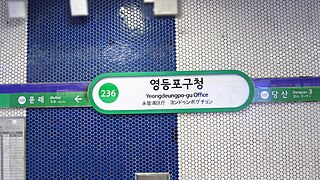
Yeongdeungpo-gu Office station is a station on Seoul Subway Line 2 and Seoul Subway Line 5. Before Mok-dong station on Line 5 was completed, this station served as a link to that neighbourhood via bus.

Gwanghwamun is the main and largest gate of Gyeongbok Palace, in Jongno-gu, Seoul, South Korea. It is located at a three-way intersection at the northern end of Sejongno. As a landmark and symbol of Seoul's long history as the capital city during the Joseon Dynasty, the gate has gone through multiple periods of destruction and disrepair. The most recent large-scale restoration work on the gate was finished and it was opened to the public on August 15, 2010.
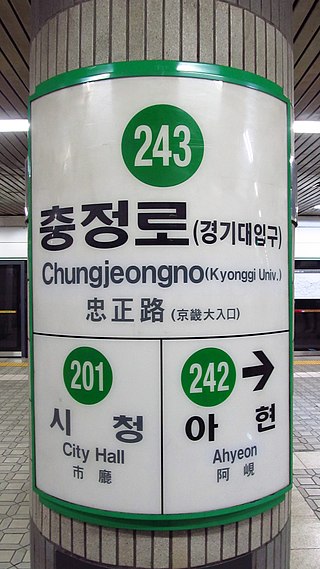
Chungjeongno Station (Korean: 충정로역) is a subway station on Seoul Subway Line 2 and Seoul Subway Line 5. It is located in Seodaemun-gu, which is a district in Seoul, South Korea. Chungjeong was the pen name of minister Min Yeong-hwan, who committed suicide protesting the signing of the Japan–Korea Treaty of 1905.

Guro Station (Korean: 구로역) is a subway station in Guro District in Seoul, South Korea. It serves Seoul Subway Line 1.
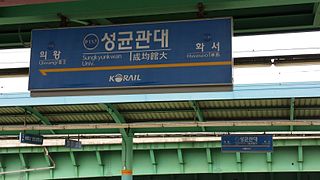
Sungkyunkwan University Station is a ground-level metro station on line 1 of the Seoul Subway in Yuljeon Dong, Jangan Gu, Suwon, South Korea. The station is nearby Sungkyunkwan University and Dongnam Health College. Travel time from Sungkyunkwan University Station to Seoul Station on Line 1 is 54 minutes, and travelling to Sungkyunkwan University's other campus, by Hyehwa Station in Seoul, takes 67 minutes, transferring to Line 4 at Geumjeong. The original station building was demolished, and a new, larger building incorporating shops, clinics, and a car park, was built, opening in late 2016.
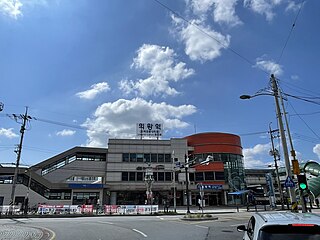
Uiwang Station is a ground-level metro station on line 1 of the Seoul Subway in Uiwang, South Korea. The station's four exits offer access to the Korea National University of Transportation, the Korean Railroad Museum and the Bugok Dong area of Uiwang. Travel time from Uiwang Station to Seoul Station on Line 1 is 50 minutes.
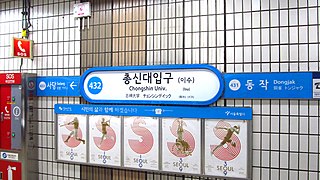
Isu Station is a subway station on the Seoul Subway Line 4 and Line 7 in Dongjak-gu, Seoul, South Korea.

Gwacheon Station (Korean: 과천역) is a station on the Seoul Subway Line 4. Despite its name, it is not the principal train station serving the city of Gwacheon; the next station on Line 4 is.
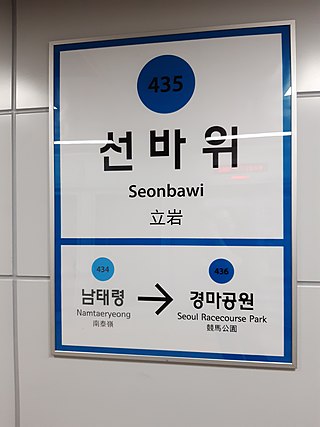
Seonbawi Station is a station on Seoul Subway Line 4 in Gwacheon, Gyeonggi-do. Most of its passengers use the station as a transfer point between various buses and Line 4. Besides a few bus stops, there really is not much else in the vicinity of this station.
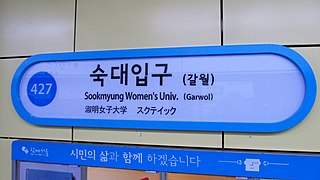
Sookmyung Women's University Station is subway station 427, on the Seoul Subway Line 4 in Yongsan-gu, Seoul. It is also called Garwol station (갈월역). It is located in front of the main entrance of the Sookmyung Women's University. There are many restaurants in the neighborhood of the subway station.

Oido station is a subway station on Seoul Subway Line 4 and the Suin–Bundang Line in Siheung, South Korea. It is the current southwestern terminus of Seoul Subway Line 4 located almost 30 kilometers southwest of Seoul, connecting Oido to other parts of Korea. A commuter rail trip between this station and Seoul Station takes over an hour, and a train servicing depot is located nearby. The name of the station was decided by the surrounding area Oido island.

Juan station is a subway station on the Seoul Metropolitan Subway Line 1 and Incheon Subway Line 2. This station receives the second-highest number of crowds along the entire Incheon line due to its proximity to the downtown area. It is also near Inha University and Inha Technical College.
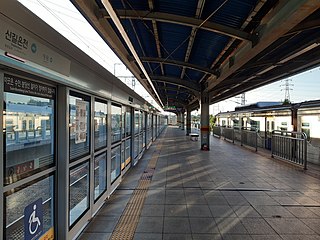
Singiloncheon Station is a railway station on Seoul Subway Line 4 and the Suin–Bundang Line in Ansan, Korea.





















